SYNOPSIS
! SPOILER ALERT !
Pretending to be Spider-Man, the
master-of-disguises super-villain
Chameleon attempts to break a friend out
of prison, but while he suceeds in having
the guards and police officers believe it
is actually Spidey they're shooting at,
he fails to achieve his actual goal and
flees the scene. When news about the
attempted break in at the prison gets to
Peter Parker, he is understandably
baffled, knowing an impostor had to have
been at work, and then decides to
investigate the matter using his press
credentials.
When he arrives at the prison
facility, he finds J. Jonah Jameson and
"Daily Bugle" journalist Ned
Leeds already on the scene to cover the
story, and is told by Jameson to make
sure he gets some good pictures.
Meanwhile, the Hulk is in the city too
- and feeling rather negative about
everything (especially "puny
humans") after a fallout with his
fellow Defenders, Doctor Strange and
Nighthawk. When he crashes into the
Chameleon's get-away car, the Chameleon
quickly puts on a Rick Jones disguise,
hoping to trick the Hulk into breaking
out his friend from prison for him,
believing that the Chameleon is his
friend Rick Jones. The ruse works, and
the Hulk stomps to the prison and begins
breaking in...
Meanwhile, at that very facility,
Peter manages to slip away and change
into Spider-Man in order to attempt to
stop the Hulk.
|
|
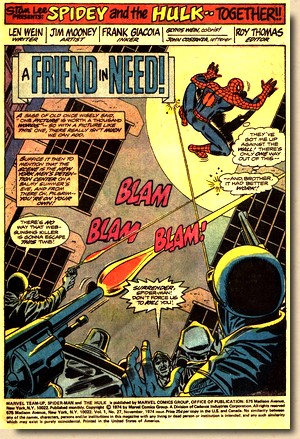 |
|
|
| |
| Somewhat unsurprisingly, though, the Hulk proves to
be rather a tad too strong for the friendly neighbourhood
webslinger and thus succeeds in his appointed task.
Spider-Man is at least able to follow the Hulk, and when
the green giant meets up with the Chameleon, we learn
that the man just freed from prison is Joe Cord, who
saved the Chameleon's life when they were both kids. |
| |
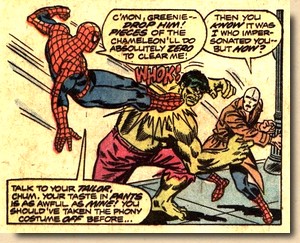
|
|
Spidey seizes the
opportunity afforded him by the general
distraction of the emotional reunion of
the two old friends, leaps in, and
reveals his old foe's true identity by
pulling off his disguise mask. This dénouement
is not only startling to the Hulk
but also hugely disappointing as he comes
to the realization that he was being used
by someone who was pretending to be his
friend. But as ole Greenskin starts to
attack the Chameleon, Spider-Man fights
him off - after all, he still needs to
prove that an impostor was at work (who
gave himself away by still wearing the
fake Spider-Man costume underneath his
trenchcoat with the pants showing).
When the Chameleon tries to escape,
Spider-Man stops his getaway car with a
giant web net. In the ensuing chaos, a
police officer accidentally shoots Joe
who throws himself in front of the
Chameleon, thus taking the bullet.
|
|
|
| |
| After this tragic turn of events, the Chameleon turns
himself over to the police, and the Hulk and Spider-Man
leave the scene - the Hulk to rejoin his fellow
Defenders, and Spider-Man after leaving the ever-babbling
J. Jonah Jameson with a web-gag parting gift. |
| |
| |
REVIEW
& ANALYSIS
|
| |
| By 1972, Spider-Man was Marvel's signature
super-hero, but in spite of his popularity and ability to
generate consistently high and rising sales both of his
own title Amazing Spider-Man and on the
merchandise front, he still only appeared as starring
character in one title. After the short-lived Spectacular
Spider-Man magazine in 1968 (which had only seen two
issues, the first of which was all black & white),
Marvel had tossed the idea of a second Spidey title back
and forth without any concrete results, but things were
finally about to change for 1972. |
| |
The March
1972 cover date production cycle
Bullpen Bulletin announced the
new title (albeit with a wrong
plural form) as its second
bulletpoint
ITEM!, right after
informing readers about an
article on Marvel Comics in the
September 16th issue of the
Rolling Stone.
"For
those myriad minons who've
been crying for more of the
ever-amazing Spider-Man,
we're introducing a brand-new
mag called MARVEL TEAM-UPS,
which co-stars the ol'
wall-crawler and none other
than the Human Torch - and
we're kicking off the series
with an offbeat Christmas
mini-saga, to boot!"
(Marvel Comics, Bullpen
Bulletin, March 1972)
Marvel
Team-Up #1 went on sale
December 21st 1971 (hence
the Christmas themed story), and
the title was an instant success.
However, while
Spider-Man
was hugely popular, the Human
Torch definitely was less so,
leading to a change in concept.
Rather
than having two permanent
headliners on the series the
Human Torch was dropped in favour
of a rotating slot for (sometimes
even non-superhero) "guest
stars" alongside Spider-Man
(of the 150 issues published
between March 1972 and February
1985, only 11 did not feature
Spidey).
|
|
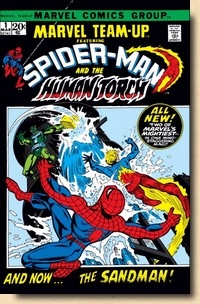
Marvel Team-Up #1
(March 1972)
|
|
|
|
| |
As a result, the series became highly formulaic,
featuring a string of unconnected and done-in-one-issue
stories.
"Either Spider-Man or that issue's
guest-star would encounter a menace and then by sheer
chance cross paths with another hero who would lend a
hand. The title's guest-stars were an equal mix of
A-list characters whose presence was likely to
increase sales and fledgling heroes being given
exposure in the hopes of launching them into stardom
but who for the most part continued to languish in
obscurity." (Miller, 2010)
|
| |
| In that respect,
Marvel
Team-Up #27 is a typical example of the series,
although one of the stronger ones as Len Wein's bringing
together of Spider-Man and the Hulk by way of the
Chameleon never feels too forced and doesn't require any deus
ex machina type of improbale constellation to
inexplicably drop from the skies. Choosing the Cameleon as villain was
another good move by Wein, and if you ever wondered just
how on earth this guy makes his disguises and elaborate
costuming work the way they do, you are given some behind
the scenes glimpses here (think hands and feet suction
cups and web-shooting gun).
|
| |
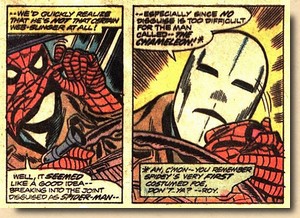
|
|
His
potential ability to turn into virtually
anybody adds a lot of interest to the
plot, too - although whipping out a Rick
Jones mask with zero preparation time
seems rather stretching it. And as a
bonus (as editor Roy Thomas is quick to
point out) this is, of course, Spidey's
first ever costumed villain, from way
back in Amazing Spider-Man #1
(March 1963). An original Stan Lee and
Steve Ditko creation, the Cameleon was
originally only revealed to be a nameless
Soviet agent using a "multi-pocket
disguise vest"
in Amazing Spider-Man #1, but
over the years his personality and
biography have seen a lot of refinement,
including a much later retcon making him
the half-brother of Kraven the Hunter
(who played an essential part in the
Chameleon's second appearance, in Amazing
Spider-Man #15 in August 1964).
|
|
|
| |
| In a nod to the original Lee
and Ditko narrative, Wein has the Chameleon once again
impersonate Spidey - just as he did way back in the
first issue of Amazing Spider-Man. But Len Wein's handling of the
plot and the characters according to established
Spider-Man lore didn't stop there.
|
| |
The
storytelling fashion surrounding
Spider-Man has always been known
for its humour, originally
injected, of course, by the
wordsmith supreme himself, Stan
Lee. He infused his jazzy
narrative with his freewheeling
and, at times, quirky puns and
jokes right off the bat, starting
out with his famous introduction
page in Amazing Fantasy
#15:
"Confidentially,
we in the comic mag business
refer to [superheroes] as
‘long underwear
characters’! And, as you
know, they’re a dime a
dozen! But, we think you may
find our Spiderman just
a bit … different!"
|
|
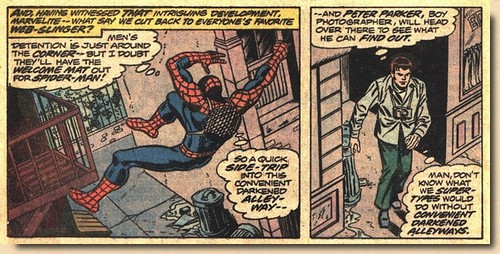
|
|
|
|
| |
| Len Wein (1948 - 2017) was only 26 when he penned
this tale for Marvel Team-Up #27, but he had a
seasoned knowledge of what Marvel Comics - and especially
Spider-Man - was all about, and he knew what comic relief
could do for a superhero yarn and how to apply it to make
it work. In a wonderfully direct link to Stan Lee's
tongue-in-cheek "long underwear characters",
Wein has Peter Parker ease up the storyline with
self-irony as he muses about what "super-types
would do without convenient darkened alleyways" in
order to switch between their identities. It's the Marvel
way of involving the reader by having the main character
point out a cliché and turn it into a witty
punchline. |
| |
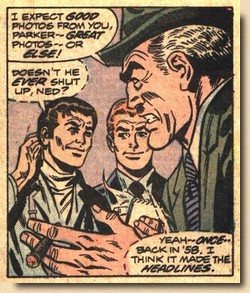
|
|
This feel for what was
needed in order to make a Spider-Man
story a really good Spidey yarn stemmed
from Len Wein's background. Together with
Marv Wolfman - whom he had met and become
friends with at the age of 11 (Wolfman,
2003) - he belonged to the group of comic
book fans who turned comic book creators
in the late 1960s and early 1970s,
bringing to the table not only a deep
enthusiasm for comics but also a profound
understanding of what made them tick, and
tick well.
"I write
my stories for me and hope that other
people will like them as well (...)
The majority of stories I've written
over the years came to me as I went
along. I've always thought of myself
as an organic writer, rather than a
cerebral one. I feel my way along as
I go." (Len Wein in
Wolfman, 2003)
"Daily
Bugle" owner J. Jonah Jameson is
comic relief poured into a character, and
Wein makes good use of him too, slipping
in a joke on JJJ mid-way through the
story and right at the end.
|
|
|
| |
|
Naturally,
the Hulk's somewhat limited
intellectual capacities are also
always good for a laugh or two,
and while Len Wein didn't miss
out on that one either, he did it
not in a mean and condescending
way but rather with an endearing
twist of amusement - after all,
there is some logic in the Hulk's
own reasoning when asked by what
he feels to be his only friend to
help that person's friend - who
surely then must be the Hulk: So
you want Hulk to help Hulk?
I am all
but certain that I would have
loved Marvel Team-Up #27
as a young teenager - after all,
Spider-Man fighting the Hulk, how
cool is that. Today, from an
adult fan reader's perspective,
the story will never rank as a
classic, but it remains highly
readable, thanks to Len Wein
keeping the plot flowing and
interest high (while safely
steering away from some of the
1970s comic book silliness), all
through those 18 pages of a
done-in-one story.
Of
course, there's also an almost
philosophical angle to the story,
a true forte of Len
Wein. In this case, the title
really does tell readers what
this stoyr is about: friendship
in time of need, and the
sacrifices true friends will
make.
|
|
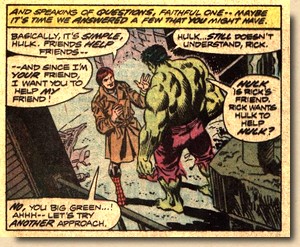
|
|
|
|
| |
| Wein would often inject some humanistic perspective
into his stories, writing tales which, underneath the
surface of a superhero yarn, were all about the good in
humans and the empathy which brings out the best in us
(another outstanding example of this is his story
"Heaven" in
Detective
Comics #514). |
| |
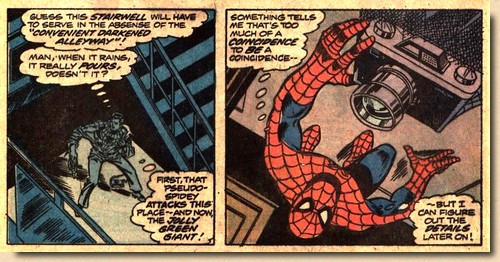
|
|
Back on the more
conventional side of things, Marvel Comic's
fans of the 1960s and 1970s loved their
editorial memory refreshers, and Wein
gave Roy Thomas plenty of opportunity for
those too (although he failed to point
out that the police call
Spider-Man a "web-slinging
killer" on the splash page because,
at the time of this story, Spider-Man was
wanted for questioning for his
involvement in the deaths of both George
Stacy (Amazing Spider-Man #90),
his daughter Gwen (Amazing Spider-Man
#131 as well as the apparent demise of
Norman Osborn (Amazing Spider-Man
#132). Maybe that was just too much to
fit into an editorial box inside a panel.
|
|
|
| |
"For
most of the super-hero yarns
(...) I try to keep a stack
of all the villain's previous
appearances." (Len
Wein in Wolfman, 2003)
The
Hulk isn't really the villain
here, but it still works: the
Marvel Style applied with
perfection - which always takes
two: a writer and an artist, and Marvel
Team-Up #27 works so well
because the classic storytelling
was accompanied by classic
artwork.
|
|
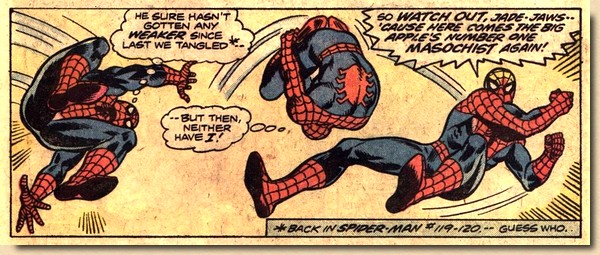
|
|
|
|
| |
| Jim Mooney (1919-2008) began his career in the 1930s
Californian science fiction pulp magazine scene.
Following art school in Los Angeles he returned to his
native New York City in 1940 and began his career as a
comic book artist, starting out at the Eisner-Iger shop,
drawing features for Ace and Fox Publications. Not long
after, Mooney turned freelance and did work ranging from
funny animal features at Timely for Stan Lee (the
beginning of a long-standing friendship) to a Catholic
comic book called Treasure Chest. In 1946, Jim
Mooney found his professional home at DC Comics, where he
would be staying for the next 22 years, starting out on
Batman as a ghost artist for credited artist Bob Kane. He
went on to work on many of DCs top-selling characters,
including Batman, Superboy and Supergirl (possibly his
best known work for DC, the back-up feature in Action
Comics from 1959 to 1968), as well as on titles such
as Dial H for Hero, House of Mystery
and Tales of the Unexpected. During that period
Mooney moved back to LA - and also ran an antiquarian
book store on the side (Evanier, 2008). |
| |
In 1968, Mooney made two moves in
his life: from LA back to NYC, and from DC to
Marvel.
"I went before they could kick me
out. They were getting into the illustrative
type of art then, primarily Neal Adams, and
they wanted to go in that direction. Towards
the end there I picked up on it and I think
my later Supergirl was quite illustrative,
but not quite what they wanted. I knew the
handwriting was on the wall, so I was looking
around and (...) went over to Marvel and I
talked to Stan. The reason I hadn't worked at
Marvel for all those years was because they
didn't pay as well as DC. I couldn't afford
to do a page for I think at that time was $30
when I was getting closer to $50 at DC (...)
but later on, when this happened, the rates
were getting a little closer to DC (...) When
I went over there I just picked the right
time I guess. John Romita was getting swamped
trying to turn out all the Spider-Man
material. [Stan] wanted me to take a shot at
Spider-Man, finalising it over John's
layouts. I said great, wonderful, and that
was the story." (Adelaide, 2004)
|
|
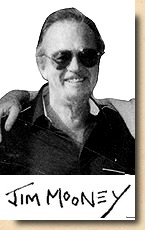 |
|
| |
| Mooney would go on to ink a lengthy run of
Amazing Spider-Man (#65, 67-88) from October 1968
through September 1970, but in reality it was
more than that. Given the enormous Spidey output
demanded from Romita, Mooney would also tighten
up the pencilwork before inking, so that in many
cases it was Mooney's work over Romita layouts
(Knowles, 2000). |
| |
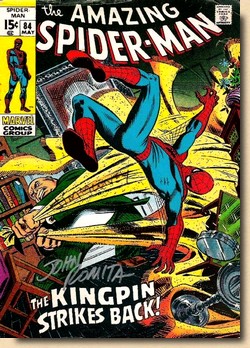
Amazing Spider-Man #84
(May 1970)
Cover signed by John Romita and
Jim Mooney (although the cover,
quite unlike the interior
artwork, is all Romita)
|
|
This
provided him with a hands-on
initiation to the Romita
Spider-Man style.
"John
[Romita] was one of the
nicest guys I ever worked
with in comics because he
could tell you what he wanted
without putting you down. He
could give you what I would
truly call constructive
criticism. We worked together
very well and I thought it
was a very compatible
relationship." (Adelaide,
2004)
This working
arrangement continued even when
John Buscema took over Amazing
Spider-Man for a few issues
(#78-81), with Jim Mooney still
working from layouts and
finishing up the artwork. It is
hardly surprising, therefore,
that when Mooney started doing
his very own Spider-Man pencils
for the first time - on both the
cover and interior artwork of Marvel
Team-Up #8 (April 1973) -
his renderings instantly had the
"classic Spider-Man"
look.
"Marvel
(...) needed someone who
could get the right look on
Spider-Man, and that's what
Mooney wound up doing
primarily for the next few
years." (Evanier,
2008)
From there on,
Mooney's pencilling work for
Marvel included a wide range of
titles and characters, including
further issues of Marvel
Team-Up as well as Crypt
of Shadows, Sub-Mariner,
Ghost Rider, Dead of
Night, Journey Into
Mystery (vol. 2), Uncanny
Tales, Marvel Spotlight
(Son of Satan), Vault of Evil,
My Love, Weird
Wonder Tales, Chamber of
Chills, Fear,
Man-Thing, Son of Satan,
Defenders, Omega the
Unknown, Daredevil,
Ms Marvel, Invaders,
Inhumans, Godzilla,
Spectacular Spider-Man, Incredible
Hulk, Avengers -
and all of this between 1973 and
1979.
|
|
|
| |
| The variety and diversity of work handed to
Mooney made him "one of the most
prolific artists to ever draw comic books" (Evanier,
2008) and speaks not only of his availability (he
had a fixed contract with Marvel) but also of his
versatility. Jim Mooney's artwork, especially
on Spidey, was the classic, clear and neat
approach which everybody loved and wanted and was
drawn to (no matter whether you were introduced
to the webcrawler through the works of Romita or
hopped onto the Marvel band waggon at a later
point of the Bronze Age). Marvel Team-Up
#27 is a good case in point.
|
| |
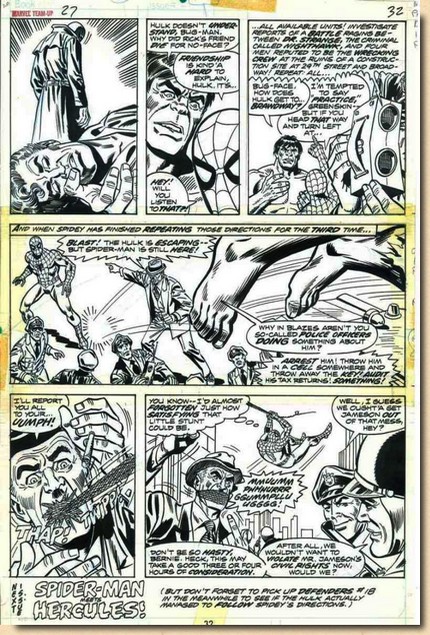
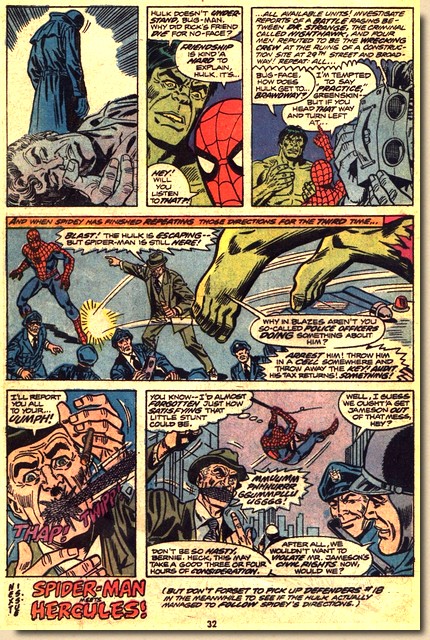
Original
artwork by Jim Mooney (pencils) and Frank Giacoia
(inks) for the final page of Marvel Team-Up #27
(scanned from the original)
and the same page as it appeared in print
|
|
| |
| Mooney settled in Florida in 1975, retired in 1985
(but continued to do freelance work both for Marvel, DC
and independent publishers), and passed away in 2008. |
| |
| |
|
| |
|
The
letters page (actually two of
them, sharing the space with an
in-house ad for Deadly Hands
of Kung Fu) was almost
entirely dedicated to replies
from readers pouring in after
Marvel had published a letter in Marvel
Team-Up #23 which called for
the abolishing of the Comics Code
and a liberalisation of standards
in Marvel's comics with regard to
sex, nudity, violence and - the
use of Zombies not just in the
black and white magazines but
also the colour comic books. The vast
majority of the numerous short
statements from readers echoed
the sentiment that while nobody
thought censorship was a good
thing, Marvel should refrain from
adding sex and violence simply
for their own sake and that of
sensationalism (a feeling taken
up by the overall editorial
comment). Zombies, on the other
hand, were given a pass pretty
much by everyone - but then
banning the walking dead from
comic books was, of course, a
true oddity of the Comics Code.
|
|
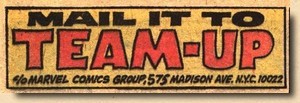
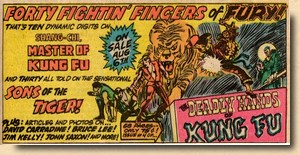
|
|
|
| |
|
| Marvel Team-Up #27 is cover-dated for the
November 1974 production cycle but actually went on sale
August 27th 1974. It was
also available as a UK
pence price variant and was published later as part
of several foreign market and language editions, with the
original cover used in Italy, Australia and Mexico (the
latter displaying a mirror image). |
| |
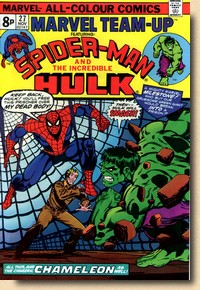
Marvel Team-Up #27
(November 1974)
UK,
Pence Price Variant
|
|
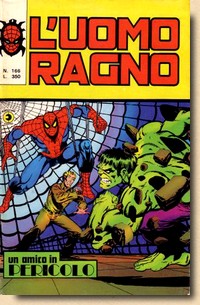
L'Uomo Ragno #166
(June 1971)
Italy, Editoriale Corno
|
|
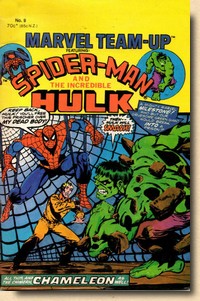
Marvel Team-Up #9
(March 1973)
Australia,
|
|
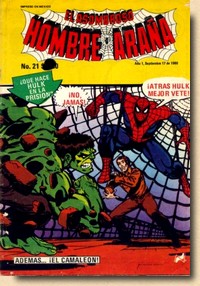
El Asombroso Hombre Arana #21
(June 1973)
Mexico,
|
|
| |
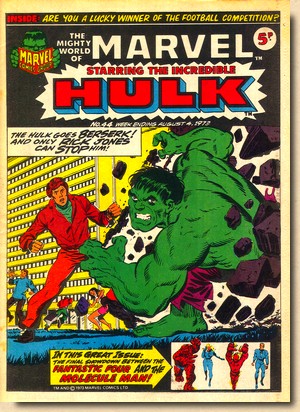
Mighty
World of Marvel #44
(August 1973)
Marvel UK, Cover Jim
Starlin
|
|
The Jim Starlin cover for
Marvel Team-Up #27 bears a
strong resemblance to another Starlin
cover, namely that of The Mighty
World of Marvel #44. The
Mighty World of Marvel was the
flagship title of Marvel
UK, the House of Idea's publishing
channel for Great Britain. Reprinting
classic material in black and white, MWOM
was published weekly (as was the norm for
UK comics in the 1970s), creating a
pronounced need for covers. Jim Starlin
was at hand in the US and ended up
providing pencils and inks for quite a
number of UK Marvel covers. Whether he
was inspired to repeat his previous work
and reuse the composition and the stance
of the Hulk for the cover of Marvel
Team-Up #27 or whether he simply
more or less did a swipe of his own work
to cut corners is anybody's guess or
opinion.
"A Friend in Need!" was
reprinted in 1980 in Marvel Treasury
Edition #27 and collected in black
and white in the Marvel Essential
Team-Up edition vol. 1 (2006). More
recently, the story has been made
available again, this time in bright
colours and on glossy pape,r in the
hardcover Marvel Masterworks Marvel
Team-Up vol. 2, published in early
2018.
The story itself has also been
reprinted for international markets
multiple times, showing the global
popularity of both Spider-Man and the
Hulk. In 1979, Editions Lug published a
French version (in Aventure de
l'Araignée #6) and Atlantic Forlag
a Norwegian one (in Edderkoppen
pocket #2); readers in Mexico were
able to read it in 1980 in El
Asombroso Hombre Araña #21 by
publisher Novedades, and a German
language version for Germany, Switzerland
and Austria was published in 1985 in Die
Spinne Extra #3 by Condor.
|
|
|
| |
| |

|
|
| |
| BIBLIOGRAPHY ADELAIDE
Comics and Books (2004) "Jim
Mooney", published online March 2004 (now
archived)
EVANIER Mark (2008) "Jim
Mooney, R.I.P.", in News From Me (Mark Evanier's
Blog), 31 March 2008
KNOWLES Chris (2000) "Jim
Mooney over Marvel", in Comic Book Artist #7
MILLER Jonathan (2010) "
Spider-Man and Company: The Wide World of Marvel
Team-Up", in Back Issue #44,
TwoMorrows
WOLFMAN Marv (2003) "Speaking
with... Len Wein", in Comics Bulletin
(30 March 2003)
|
| |
| |
The
illustrations presented here are
copyright material.
Their reproduction for the review and
research purposes of this website is
considered fair use
as set out by the Copyright Act of 1976,
17 U.S.C. par. 107.

(c) 2020
|
|
|
|